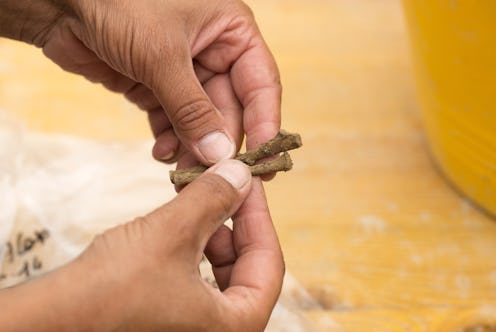Life
Researchers Finally Explained The 6-Inch Human Skeleton That Has Stumped Us For 2 Decades

For the last two decades, scientists have struggled to place a six-inch mummified human skeleton discovered in northern Chile's Atacama Desert. The skeleton's shape was so unusual, in fact, that it initially led some researchers to suspect it belonged to an extraterrestrial. But as much as I'd like to believe a race of teeny aliens once called South America home, it appears the body was that of a woman with a number of bone disorders that manifested in a highly unusual manner.
The bone disorders were discovered and reported by a team of researchers at Stanford University, and published this week in the journal Genome Research. The researchers were studying the bones belonging to the tiny mummy dubbed "Ata," who one man discovered wrapped in a white pouch in a ghost town near a church in the aforementioned Atacama Desert in 2003, per the New York Times. The skeleton was only half a foot long, had only 10 ribs instead of 12, featured a long, pointy skull, and had large eye sockets, which was why some people started to suspect she was not of this world.
According to the Chicago Tribune, Ata ended up on the black market, where she managed to make her way into the hands of an anonymous collector. Steven Greer, a former emergency room doctor and UFO transparency advocate, met the collector at a UFO conference and extracted part of Ata's bone in hopes of revealing her extraterrestrial origins. In the end, though, Greer found Ata was human, and Garry Nolan, a Stanford researcher who tested her bone, hypothesized she had lived to about six or eight years old, hence her tiny size. (That research was part of a 2013 UFO-related documentary dubbed Sirius, which, per the Huffington Post, was helmed by Greer. People were very disappointed Ata was not actually an alien.)
It appears Nolan's small investigation inspired him to look into Ata a little further, and he enlisted a number of experts to explore how Ata ended up looking like she did. Nolan and his team found DNA in Ata's bone marrow cells, then studied her genes to see how they matched up with individuals who suffered from bone disorders. It turns out they matched up fairly well, although Ata's case was still certainly unusual.
Indeed, researchers found Ata didn't have any known bone disease, but she did have a number of genetic mutations leading to her unique skeletal shape — in fact, one researcher found Ata could have had as many as 54 rare mutations in just one gene. "To me, it seems that when doctors perform analyses for patients and their families, we're often searching for one cause — one super-rare or unusual mutation that can explain the child's ailment. But in this case, we're pretty confident that multiple things went wrong," Atul Butte, one of the lead researchers in the study, told Science Daily.
Those mutations, among other things, could explain why Ata's bones were as developed as those of a six-year-old, but she herself was about the length of a pen. It's possible she had dwarfism; it's also possible she was a stillborn infant, but her bones matured faster than a normal fetus, but even that wasn't conclusive. "There is no single slam-dunk finding that explains the bizarre appearance of this individual," Daniel G. MacArthur, a geneticist who was not involved in the study, told the New York Times.
There were some more-or-less conclusive findings, however. For instance, Ata's genes suggest she's of indigenous Chilean descent, although she does have some European ancestry, so likely she was born after the Europeans colonized South America in the 16th century (her DNA also suggests she's less than 500 years old). She is also definitively human, with 98 percent of her DNA confirmed.
"We thought this would be an interesting exercise in applying the tools that we have today to really see what we could find," Butte said. "The phenotype, the symptoms and size of this girl were extremely unusual, and analyzing these kinds of really puzzling, old samples teaches us better how to analyze the DNA of kids today under current conditions."
It's an exciting moment for scientists, if a disappointing one for UFO enthusiasts.